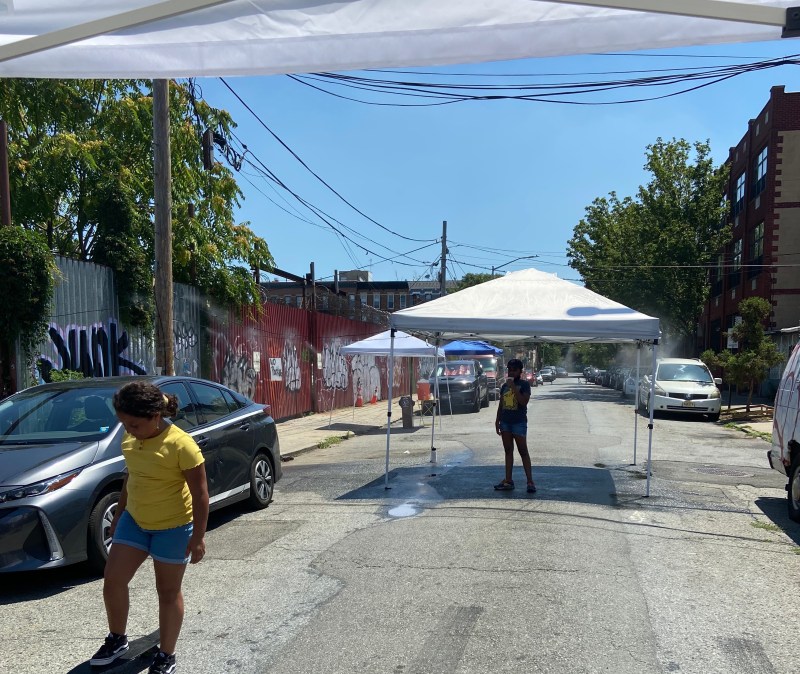A Local Initiative is Cooling Off Streets in Red Hook
Pop-up infrastructure shades under-served area near NYCHA housing.

As the city swelters, residents in the Red Hook neighborhood of Brooklyn are turning local “open streets” into oases of cool.
Hundreds of neighbors came out last Saturday to check out shaded seating and other features to beat the heat on W. Ninth Street from Henry to Hicks streets in the heavily immigrant, Latinx area, which has been hit hard in the coronavirus pandemic.
A street with little shade, W. Ninth Street lies around the corner from the Redemption Church, which each Saturday runs a free-food distribution at the Red Hook Initative that draws many in the community — who must wait online for packages under a beating sun. An official city “open street,” it is a block away from the city’s mammoth Red Hook Houses.
The temporary, pop-up cooling infrastructure on West Ninth was part of a project spearheaded by two local groups, the RETI Center and Resilient Red Hook, called Red Hook Cool Streets. RETI and Resilient Red Hook began organizing Red Hook Cool Streets in June; they hope to run the program each Saturday through early September.
The goal is to establish several streets — West Ninth between Hamilton Avenue and Columbia Street; Columbia between W. Ninth and Halleck sts.; Loraine and Wolcott from Columbia Street to Van Brunt Street; and Pioneer Street from Columbia Street to Conover Street — as “cool corridors” throughout the neighborhood. Each corridor provides a route for residents to access the Brooklyn waterfront.

For the organizers, cooling the streets is a matter of social justice — even of life and death.
“The same populations who bear the brunt of climate disasters were seeing the worst of the pandemic, and the summer months represented a rising wave of danger,” said RETI Center board chair, Gita Nandan.
A broad coalition of groups — including Red Hook Initiative, Good Shepherd Services, Pioneer Works, Red Hook Community Justice Center, and Portside New York. Center for Resilient Cities and Landscapes, Resilient Cities Catalyst, J.M. Kaplan Fund, and the New York City Department of Youth & Community Development — provided support and funding.
“We are trying to challenge the status quo of place-making, and develop a community-centered process which is inclusive and transparent, while at the same time experimental, fun, and collaborative,” said Thad Pawlowski of Resilient Red Hook.

Red Hook Cool Streets augments the city’s own small, recently launched Cool Streets program. The NYC effort reaches only 16 blocks in a city of almost 9 million — and unfortunately suffers from a lack of safety. Among its designated streets, some do not have proper facilities, such as sawhorses or other barricades, for stopping vehicular traffic, Streetblog reported.
On W. Ninth Street, residents waiting in line for the food distribution offered ideas for improving health and safety in the area, said Nicolas Garcia, a volunteer with the RETI Center who spoke with residents in Spanish. Some were looking to have social-distancing markers placed on the street, similar to those in nearby Domino Sugar Park, in order to help them safely socialize during their weekly salsa classes hosted by the Red Hook Community Justice Center.
Others applauded the idea of misters, which will help neighborhood children cool off as they play. Still others stressed the need for shade. The feedback the residents supplied will aid Red Hook Cool Streets’s design team to improve further pop-ups.
The organizers of Red Hook Cool Streets created a GoFundMe page to support it and the youth volunteers working on the program. To volunteer, visit RETICenter.org. Follow the program as it develops on Facebook.com/RETICenter or https://www.instagram.com/reti_center/.





